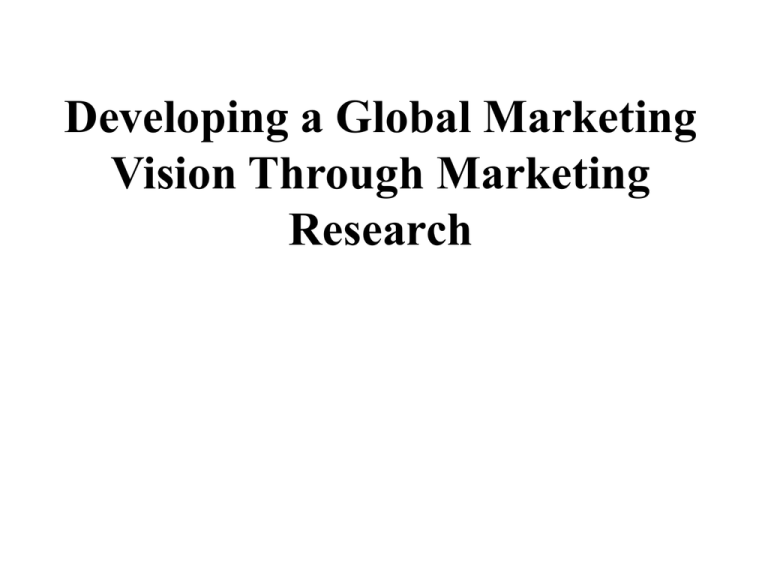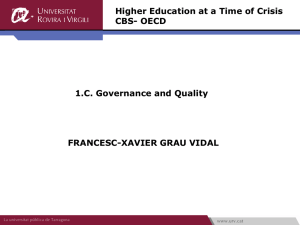Research in global markets
advertisement

Developing a Global Marketing Vision Through Marketing Research Chanel: ‘satanic dress’ Camellia flower used for Funerals in Brasil Launched a perfume with camellia fragrance Overlooked customs and Beliefs Had to withdraw the perfume RED or WHITE? 7 OR 8? • What is international marketing research? • International marketing research is the systematic design, collection, recording, analysis, interpretation, and reporting of information pertinent to a particular marketing decision facing a company operating internationally. International Marketing Research I. Differences with Domestic Research - New parameters - New environments - More factors to consider - More competitors - Are results comparable? Recognizing the Need for Research • Reasons that executives may view international research as unimportant: – Lack of sensitivity to differences in consumer tastes and preferences. – Limited appreciation for the different marketing environments abroad. – Lack of familiarity with national and international data sources and the inability to use them. – Actual but limited business experience in a country or with a specific firm may be used as a substitute for organized research. International Marketing Research II. Why do International Marketing Research? - Reduce Risk of Failure - Identify opportunities - Lead to more informed decisions - Reduce mistakes III. The IMR Process - Step 1 : Problem Definition - Step 2 : Examine Secondary Data The Scope of International Marketing Research International Marketing Decisions Requiring Marketing Research M arketin g M ix T yp e o f R esearch D ecisio n P roduct policy F ocus groups and qualitativ e research to generate ideas for new products S urv ey research to ev aluate new product ideas C oncept testing, test m arketing P roduct benefit and attitude research P roduct form ulation and feature testing P ricing P rice sensitiv ity studies D istribution S urv ey of shopping patterns and behav ior C onsum er attitudes toward different store types S urv ey of distributor attitudes and policies A dv ertising A dv ertising pretesting A dv ertising posttesting, recall scores S urv eys of m edia habits S ales S urv eys of responses to alternativ e types P rom otion of prom otion S ales F orce T ests of alternativ e sales presentations International Marketing Research IV. Data Sources - a wide variety are available. V. Advantages of Secondary - Fast - Inexpensive - Can aid in further research International Marketing Research VI. Disadvantages of Secondary Data - May not be accurate - Difficult to trace methodology - Data becomes quickly outdated - Not collected for specific task at hand Sources of Data • Governments – Departments of Commerce, Agriculture, State, Treasury, and U.S. embassies abroad • International organizations – United Nations’ Yearbook, World Bank’s World Atlas, Organization for Economic Cooperation and Development (OCED) and World Trade Organization (WTO) publications • Service organizations – Banks, accounting firms, freight forwarders, airlines, and international trade consultants The Research Process Major Sources of Secondary Data U.S. DEPARTMENT OF COMMERCE Foreign Trade Report: U.S. exports by commodity and by country Global Market Surveys: Global market research on targeted industries INTERNATIONAL MONETARY FUND International Financial Statistics: Monthly report on exchange rates, inflation, deflation, country liquidity, etc. UNITED NATIONS Statistical Yearbook: Population, production, education, trade, etc. THE ECONOMIST E.I.U. World Outlook: Forecasts trends for 160 Countries Marketing in Europe: Product markets in Europe International Marketing Research VII. - Consider Costs and Benefits of the Research Effort VIII. - Primary Data Collection International Marketing Research Primary data is collected for the specific research problem at hand 1)Major Types of Primary Research i) ii) iii) Exploratory Descriptive Causal i) ii) iii) iv) Interviews Focus Groups Observation Surveys 2)Research Techniques International Marketing Research IX. Analysis and Interpretation X. Communicate Results Effectively The Research Process Table 6.4: Comparison of European Data Collection Methods Mail Telephone Central location/ streets Home/work Groups Depth interviews Secondary France 4% 15 Netherlands 33% 18 52 -13 12 4 37 --12 -- Sweden Switzerland U.K. 23% 8% 9% 44 21 16 -8 5 2 4 -44 6 8 8 -54 11 --- Talents Required to Analyze and Interpret Research Information • Cultural Understanding • Creative Talent for Adapting Research Findings • Skeptical Attitudes when Handling Both Primary and Secondary Research Challenges: - Language: “tabled” in US vs UK English - postpone consideration of vs. - present formally for discussion at a meeting - Translation: “Chevy Nova” - Syntax: - Cultural norms: Ketchup? No, soy sauce! Instant coffee in France? Being alone for an interview with a man in Middle-East? Discuss grooming?? - Time zones : no interviewing in Japan during work hours - Foreign holidays: many? Less? Sampling issues: China has a total population of 1.2 billion, 350 million of which live in urban areas of 622 cities and scores of smaller towns. Of the cities, only 32 have populations of at least one million, while 42 have populations between 500,000 and one million, and the remaining 548 have populations of less than 500,000. What is a representative sample?? Technology: In Germany, telephone penetration did not reach the 80% level until the mid-1980s, long after that milestone had been reached in the United States. Today, less than 10% of all households in India have telephones, and telephone penetration in Brazil is less than 50% in large cities. What picture regarding the internet?? Legal issues: What is privacy, what is legal to collect? Native speakers as interviewers: what if literacy is low? Questionnaire length: Of China's major cities, refusal rates are estimated at 32% in Guangzhou,22% in Beijing, and 10% in Shanghai. in 20 minutes people get tired. Translated into Italian, a 20 minute American questionnaire will last only approximately 18 minutes. Translated into French, the same questionnaire will take 22 minutes. Incentive to respond: expected in Brazil, insulting in other. Currency fluctuations: talk about budget!! • There is no substitute for trusted, on-the-ground contact sources to provide context • Consider using a single research vendor familiar with the international marketplace. • Allow more time to plan and execute an international study. • Conduct research studies in markets similar to the home country prior to conducting research in new and unfamiliar parts of the developing world. Newcomers to the international market research arena should take small steps in familiar markets to provide a solid foundation prior to expanding into new, unfamiliar markets. • Supplement custom market research insights with as much secondary information about foreign markets as available.










